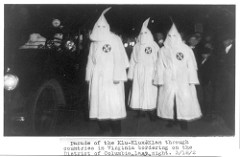Introduction

Parade of KKK members through Virginia Counties, in 1922
This project examines racial discrimination in the United States from the late 1800’s to present day. My project will have a focus on the Civil Rights Movement and the brave people considered leaders of it.
Throughout history, nonwhites have always faced discrimination from the hands of whites. After slavery was abolished in 1865 and southern blacks were made free, the whites have always found a way to keep them lower than the whites. One of the most famous ways this was done can be seen in the rise of the KKK in the south(Parsons 2015). However, the main occurrence of discrimination at the expense of blacks were the Jim Crow laws that kept them segregated from the whites. Passed during and shortly after the Reconstruction era, these laws made it illegal for blacks to practically exist in the same space as whites, forcing them to have their own churches, schools, even things as little as water fountains needed to be built for blacks only. Along with the Jim Crow laws, the black community also faced discrimination at the polls, being forced through arbitrary hoops in order to vote, if they were able to pass these tests at all(Faulkenbury 2018). With these unreasonable laws and unfair treatment of blacks, eventually leaders arose who were fed up with the unequal treatment and were not afraid of letting their voices be heard. These leaders, most notably Martin Luther King Jr and Malcolm X, pushed for the black community to band together and reject the racial discrimination. This led to King’s demonstrations, most famously his marches from Selma to Montgomery(Ling 2015). These marches were met with violence from the whites, but the blacks never fought back. The Selma march demonstration coincided with a stressful time during the Cold War, making president Johnson, along with other officials, afraid of backlash overseas critiquing the state of their own democracy. Because of this, Johnson passed the Voting rights act of 1965, assuring all blacks had the ability to vote. Along with this act, in 1964 president Johnson also passed a introduced a bill to congress, that was first presented by President Kennedy before his assassination, that would abolish segregation of the races. The Civil Rights Act of 1964 was an important step in the right direction, but unfortunately just because blacks had legislation on their side does not mean whites agreed with it..
Along with the unequal treatment of blacks in history, immigrants have also faced harsh times at the hands of whites. During the mid 1800’s during Ireland’s potato famine many families immigrated to America. During the Irish immigration many employers discriminated against the fresh immigrants by not accepting any of their job applications. For the few that did manage to find work, they were most likely unable to find housing as the home owners also did not wish to rent to the Irish immigrants. Moving past the Irish, shortly after the Japanese bombing on Pearl Harbor, the American government forced Japanese-American citizens into internment camps to prevent any sympathisers from acting out against the United States. Placing the Japanese into internment camps went against the actions they were fighting against in Germany, and was highly hypocritical.
This project will define the hardships that blacks and immigrants in the distant, and not so distant past have had to endure. My project will have a focus on the leaders that arose during these hard times to lead the black community to a better life than they had currently at that time. As my project will deal with the KKK and their discrimination against blacks, my project will start when they first emerged around 1865, shortly after slavery was abolished by President Lincoln. Where as racial discrimination has come back into the spotlight with the most recent election, I will finish my project with an examination of that.
Starting with the rise of the Ku Klux Klan, this project will provide examples based on the continued discrimination of anybody except the whiteman, and how the discriminated parties eventually grew strong enough to resist. A strong example of this is seen in comparing early KKK sources which show extreme violence towards blacks and evokes a fearful image to mid 1900’s Civil Rights movement protests, where blacks no longer fear violence towards them and are willing to do anything to accomplish their freedom(Riches 2004).
